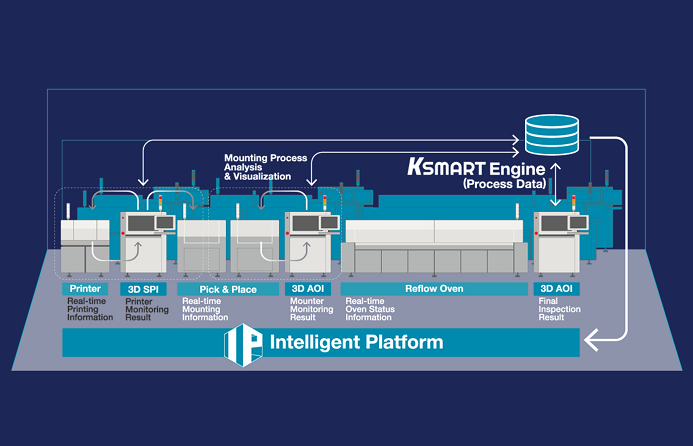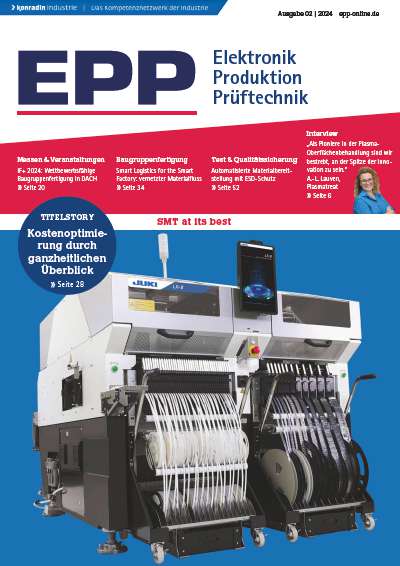The Hesse & Knipps Bondjet 710/810 series of automatic wedge bonders covers all applications using gold, aluminum and copper fine-wire. No longer does the user have to compromise between the highest possible product quality and machine throughput.
Hesse & Knipps, Paderborn, Germany
This machine concept covers many application requirements by its modularity and bonding technology encompassing precise feedback control and incorporating highly effective user software with a multitude of machine monitoring features.
Application areas
Unusually large components can easily be handled because all four of the machine axes are located in the bonding head, leaving a large uncluttered loading area for devices. With an area of 305 x 180mm, the Bondjet has the largest standard working zone available worldwide in automated gear. Large working areas are becoming increasingly important for a number of applications, including hybrid modules or chip-on-board (COB) or systems-in-a-package (SiP). Those modules often have numerous circuits and devices on a single substrate.
The machine accuracy (repeatability) is 3µm, giving the possibility to bond even very demanding circuits. Additionally, the specially designed, very precise cinematic motion system permits trouble-free processing in ultra-fine-pitch applications down to 50µm. The open architecture of the machine combines this accuracy with the maximum flexibility in automatically loading and unloading. Indexers and magazine handlers for any carrier system or for directly transporting substrates or PCBs of up to 312 x 307mm can easily be integrated. Control is taken care of by a built-in PLC, and all machines are fully SMEMA-compatible.
Choice of bond heads
An assortment of bond heads (with 45°/ 60°/89° deep access) helps to successfully tackle a widespread manufacturing mix. The machine design allows a selection of bond heads to be used and changed rapidly, normally within 10 to 15 minutes (depending on just the application). Bond heads are fitted with the most modern actuators available, designed using piezo technology. Piezo is a ceramic material which length changes when voltage is applied, well known as the piezoelectric effect. Clever use of this effect and the development of special controls gives the possibility to feed and tear the wire with an accuracy of 1µm just by using a software-based parameter and without any mechanical adjustments. The process of opening and closing the wire clamp is a-chieved in a similar way.
Contrary to convention-al technologies, Hesse & Knipps have also come up with a wire-handling scheme which shows no parasitic oscillations during movement of the actuators. The movement of the mechanical parts follows specially defined trajectories where there are no movements against solid parts.
The current state of knowledge in the industry is that bond heads need to have regular maintenance, because the head movements are not frictionless. This cau-ses abrasion which, when combined with lubricants, can in the worst-case jam up the actuators. Traditionally, regular dismantling and cleaning of actuators has circumvented this. This disadvantage has been avoided on this bond-head design that has, by the way, been implemented for the first time worldwide. The Bondjet eads use solid-state joints which are wear-free and therefore need no regular main-tenance.
The use of a sophisticated and effective motion control system means that the bond head is guaranteed to precisely follow the physical path, required to create a straight wire loop, assuring consistency. This approach provides excellent conditions for the formation of long loops with the utmost similarity and minimal chance of tilting. Users currently form loops up to 25mm long with a pitch of 70µm, using 33µm aluminum wire. Sometimes some hundreds of loops are formed in this way.
At the other end of the scale, the special bonding trajectories also enable very short loops to be formed without any problems. These short loops are often used in the area of RF and microwave applications. Users are, for example, able to form gold-wire lengths as short as 70µm at a height of 50µm.
For other applications such as fiberoptics and microsystems, wires are bonded directly onto the wafer (known as chip on wafer). The Bondjet can completely process an entire 150mm wafer without the need for any indexing. Chip handling is also eased by automatically imported data from NMF files, which are wafer mapping data, generated by other processing gear. Quality data are automatically written to a NMF file so that they are available to the next machine in a manufacturing line.
As a standard, the Bondjet uses gold and aluminum wires with diameters from 17.5µm up to 85µm. Gold wire can be bonded from ambient temperatures into the region of up to 180°C. Temperature-controlled heating modules are therefore available with the BondJet which can, if required, be integrated into the indexer system, including a pre-heating stage. Currently, the first applications are also being developed using copper wire.
The deep-access head is designed to handle both wire and ribbon. Ribbon with sizes from 6 x 75µm up to 25 x 150µm can be successfully bonded. Conversion between these sizes is very simple, with only the wire spool and wedge tool needing to be changed. In spite of the great flexibility of the machine, it has a veryfast processing speed. Users routinely achieve throughputs of at least 3 bonds per second. The speed for bonding one wire is about 200ms (2mm loop length, 45° wire angle).
Recognition system and user software
A range of lighting options is provided, including standard ring lights (with LEDs) and light cupolas which produce direct light and indirect light with a diffuser. During application programming, the user can choose any intensity combination of both light sources. The special lighting of the diffuser works on the darkfield principle. Also, tilted chips can be detected easily, because of the decrease of lightness. There are also several pattern-processing algorithms: determination of focal point, detection of single leads, standardized grayscale algorithm and alternative pattern processing.
The user software is modular and easy to learn. Bond programs are portable, reference systems and programmed wires are illustrated graphically, loop shapes can be freely defined, programs can be saved and recalled in just a few seconds, etc. The recognition system can be used to recognize a wide variety of structures. It also has the benefit of solving the problem of significant differences in batch-to-batch quality by the ability to learn several alternative pictures for the same structure.
Quality control/documentation
Good quality-control features are mandatory. The Bondjet complies with this requirement by automatically measuring and checking the deformation of wires (in a group or for a single item) within a programmable area of tolerance. All defects and out-of-tolerance events are recorded automatically. Additionally, a printout can be made of the deformation curves.
More advanced quality monitoring is afforded by the PBS 100 customized process data controlling system. All relevant quality data can be transferred in real-time from a BondJet into this system. Thus, the data is immediately available for statistical analysis and process and production reporting and documentation. Up to 50 machines can be simultaneously connected to the PBS 100, making it a valuable aid for any production situation. Data monitoring takes place in real-time, allowing the management to be continuously updated on production status, and giving the opportunity to supervise a large number of machines.
EPP 190
Zusammenfassung
Mit einem Wedgebonder können Drähte aus Gold, Aluminium oder Kupfer in sehr fordernden Applikationen bis hin zu Mikrowellen-Hybriden verarbeitet werden. Mit einem modularen Maschinenkonzept und realativ einfach austauschbaren Bondköpfen läßt sich das System ziemlich rasch umrüsten. Clevere Steuerungs- und Überwachungselektronik stellt präzise Arbeitsweise sicher, wobei der Wartungsaufwand drastisch reduziert wurde.
Résumé
Un wedgebonder permet de transformer les fils d’or, d’aluminium ou de cuivre, dans les applications très exigeantes, jusqu’aux hybrides à micro-ondes. Grâce à un concept de machine modulaire et à un remplacement relativement aisé des têtes d’assemblage, le système peut être rééquipé assez rapidement. Une électronique de commande et de surveillance sophistiquée assure un fonctionnement précis, l’entretien nécessaire ayant parallèlement été considérablement réduit.
Sommario
Con un Wedgebonder é possibile lavorare fili in oro, alluminio o rame in applicazioni molto complesse, compresi gli ibridi a microonde. Grazie ad un concetto di macchina di tipo modulare e alle teste Bond di semplice intercambiabilità é possibile equipaggiare il sistema in maniera particolarmente rapida. Degli ingegnosi dispositivi di controllo e di sorvegliamento assicura un’alta precisione di funzionamento, riducendo drasticamente il fabbisogno di manutenzione.
Unsere Webinar-Empfehlung
Die Nutzung der 3D-Mess- und Prozessdaten bringt die Produktionssteuerung auf die nächste Stufe. Echte 3D-Messung ermöglicht KI-basierte Prozessmodellierung zur Vorhersage von Parameteränderungen und -defekten oder zur Ursachenanalyse bis hin zu einzelnen Werkzeugen und Best…
Teilen:














